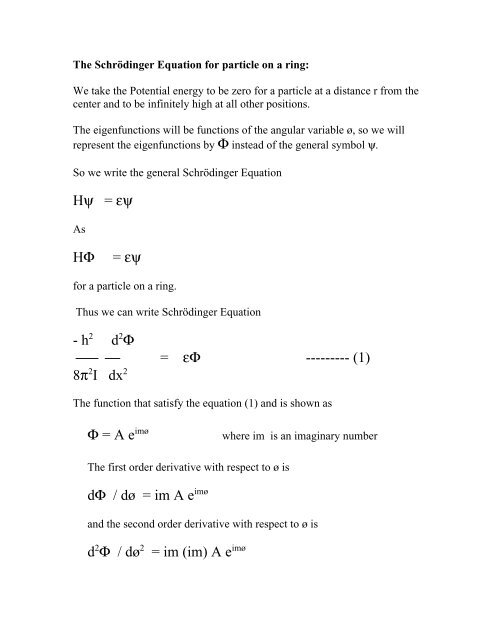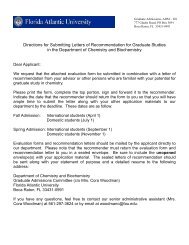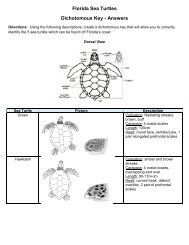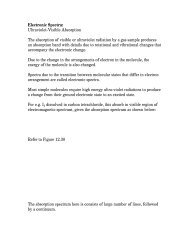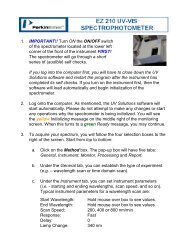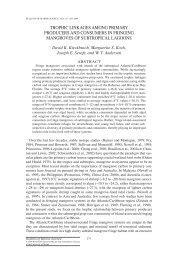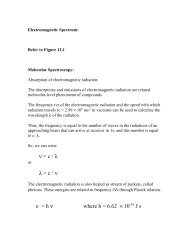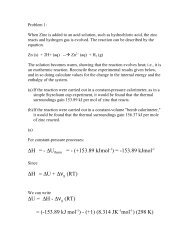Schrödinger Equation for Particle in Ring
Schrödinger Equation for Particle in Ring
Schrödinger Equation for Particle in Ring
You also want an ePaper? Increase the reach of your titles
YUMPU automatically turns print PDFs into web optimized ePapers that Google loves.
The Schröd<strong>in</strong>ger <strong>Equation</strong> <strong>for</strong> particle on a r<strong>in</strong>g:We take the Potential energy to be zero <strong>for</strong> a particle at a distance r from thecenter and to be <strong>in</strong>f<strong>in</strong>itely high at all other positions.The eigenfunctions will be functions of the angular variable ø, so we willrepresent the eigenfunctions by Φ <strong>in</strong>stead of the general symbol ψ.So we write the general Schröd<strong>in</strong>ger <strong>Equation</strong>Hψ = εψAsHΦ= εψ<strong>for</strong> a particle on a r<strong>in</strong>g.Thus we can write Schröd<strong>in</strong>ger <strong>Equation</strong>- h 2 d 2 Φ8π 2 I dx 2= εΦ --------- (1)The function that satisfy the equation (1) and is shown asΦ = A e imøwhere im is an imag<strong>in</strong>ary numberThe first order derivative with respect to ø isdΦ / dø = im A e imøand the second order derivative with respect to ø isd 2 Φ / dø 2 = im (im) A e imø
d 2 Φ / dø 2 = -m 2 A e imø= - m 2 ΦThus, the equation (1) becomes- h 2 (- m 2 Φ ) = εΦ8π 2 Ih 2 m 2 = ε --------- (2)8π 2 Iwhere m = 0, ±1, ±2, ±3 ……This is the same result, which was shown by fitt<strong>in</strong>g de Broglie waves <strong>in</strong>tocircumference with a general symbol n <strong>for</strong> quantum number.The pattern of the energies of the allowed rotational states is shown asfollows.
For a particle-on-a-r<strong>in</strong>g, we can write the probability as2π∫ Φ 2 dø = 10When solutions to the Schröd<strong>in</strong>ger equation satisfy such equation, thesolutions functions are said to be normalized.The normalization of function Φ, gives the value <strong>for</strong> A.2π∫ Φ 2 dø = 102π∫ Φ * Φ dø = 102π∫ (Ae -imø ) (Ae imø ) dø = 102π∫ A 2 dø = 102πA 2 [ ø ] = 10A 2 [ 2π ] = 1
A = 1 / 2π ------- (3)Thus the normalized eigenfunction Φ can be written asΦ = A e imøΦ = (1 / 2π )( e imø ) -------- (4)where m = 0, ±1, ±2, ±3 ……Angular-Momentum values:We can use this function to get the values of angular momentum operatorand deduce the angular momentum associated with each quantum stateL z Φ = (h / 2 π i) ( dΦ /dø)From equation (4)h d 1L z Φ = ( e imø )2 π i dø 2πh 1L z Φ = (im) ( e imø )2 π i 2πFrom equation (4)hL z Φ = (im) Φ2 π i
hL z Φ = m Φ2 πThus, the angular momentum ishL z = m ------ (5)2 π where m = 0, ±1, ±2, ±3 ……Thus, the two states at each energy other than <strong>for</strong> m = 0, have angularmomenta which correspond to the particle mov<strong>in</strong>g clockwise and anticlockwise,depend<strong>in</strong>g upon the sign of m and are uni<strong>for</strong>mly distributedaround the r<strong>in</strong>g.The Heisenberg Uncerta<strong>in</strong>ty Pr<strong>in</strong>ciple and the <strong>Particle</strong> on the r<strong>in</strong>g:Accord<strong>in</strong>g to Heisenberg, there is an <strong>in</strong>herent limitations to the related orconjugate properties of particles.The momentum p and the position x are the conjugate properties.Accord<strong>in</strong>g to Heisenberg, we cannot know the precise values of p and x.Any calculated values of p and x will be uncerta<strong>in</strong> to the extent of ∆p and∆x.And thery are related to each other as∆p ∆x = hwhere h is planck’s constant.At the lowest energy state, i.e. m = 0The angular momemtum Lz
From equation 5hL z = m = 02 πRotation <strong>in</strong> three dimesions:The Schröd<strong>in</strong>ger equation <strong>for</strong> a particle <strong>in</strong> a three dimensional system iswritten as follows if the Potential energy experienced by a particle is zero:- h 2 d 2 ψ d 2 ψ d 2 ψ+ + = εψ -------- (6)8π 2 m dx 2 dy 2 dz 2The Schröd<strong>in</strong>ger equation can be expressed <strong>in</strong> terms of polar co-ord<strong>in</strong>atesand moment of <strong>in</strong>ertia I = mr 2 as follows:8π 2 I s<strong>in</strong>θ dθ s<strong>in</strong> 2 θ 2- h 2 1 d dψ 1 d 2 ψs<strong>in</strong>θ + = εψdθ dø------- (7)
Angular Momentum:The angular momentum operator along z direction is given asL z = (h / 2 π i) [x (d/ dy) - y (d/dx)]SimilarlyThe angular momentum operator along x direction is given asL x = (h / 2 π i) [y (d/ dz) - z (d/dy)]AndThe angular momentum operator along y direction is given asL y = (h / 2 π i) [z (d/ dx) - x (d/dz)]Thus, the square of the total angular momentum operator <strong>for</strong> threedimesional system is given asL 2 = L x2+ L y2+ L z2Us<strong>in</strong>g Polar co-ord<strong>in</strong>ates, the angular momentum operator <strong>in</strong> z-directionisgiven asL z= (h / 2 π i) ( d /dø)And the square of the total angular-momentum operator ash 2 1 d d 1 d 2L 2 = (s<strong>in</strong>θ) +4π 2 I s<strong>in</strong>θ dθ dθ s<strong>in</strong> 2 θ dø 2------- (8)
As we know that from equation (5), the angular momentum <strong>in</strong> z direction isquantized <strong>in</strong> units of (h/2π) and is given ashL z = m2 π where m = 0, ±1, ±2, ±3 ……Then, the total angular momentum is given ashL = l ( l + 1) ------ (9)2 πwhere l = 0, 1, 2, 3 ……andwhere m = 0, ±1, ±2, ±3 …… , ±l.


